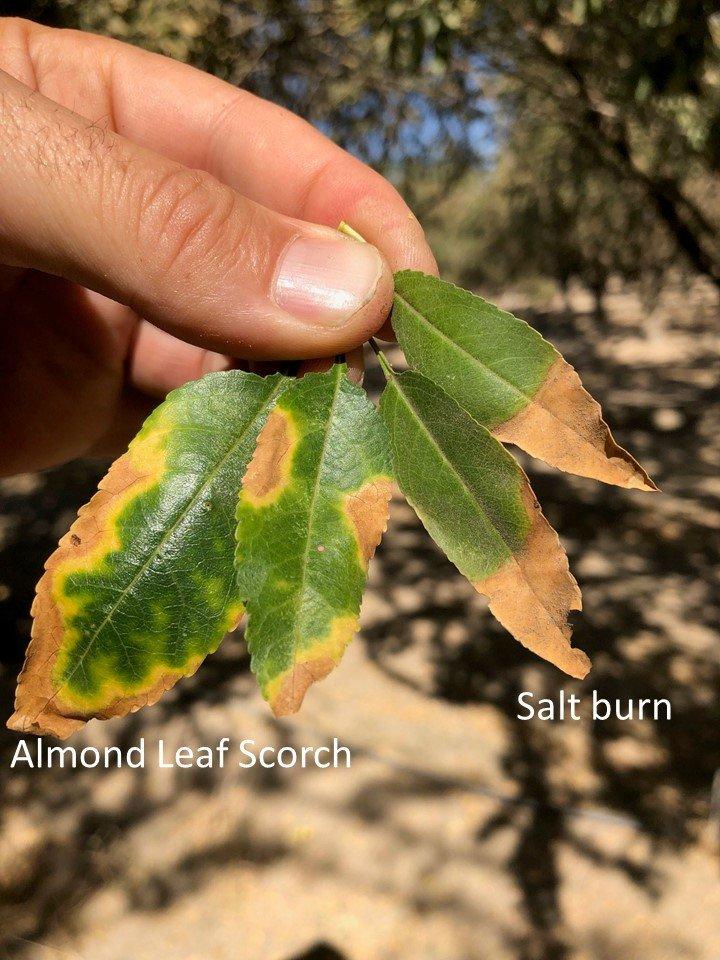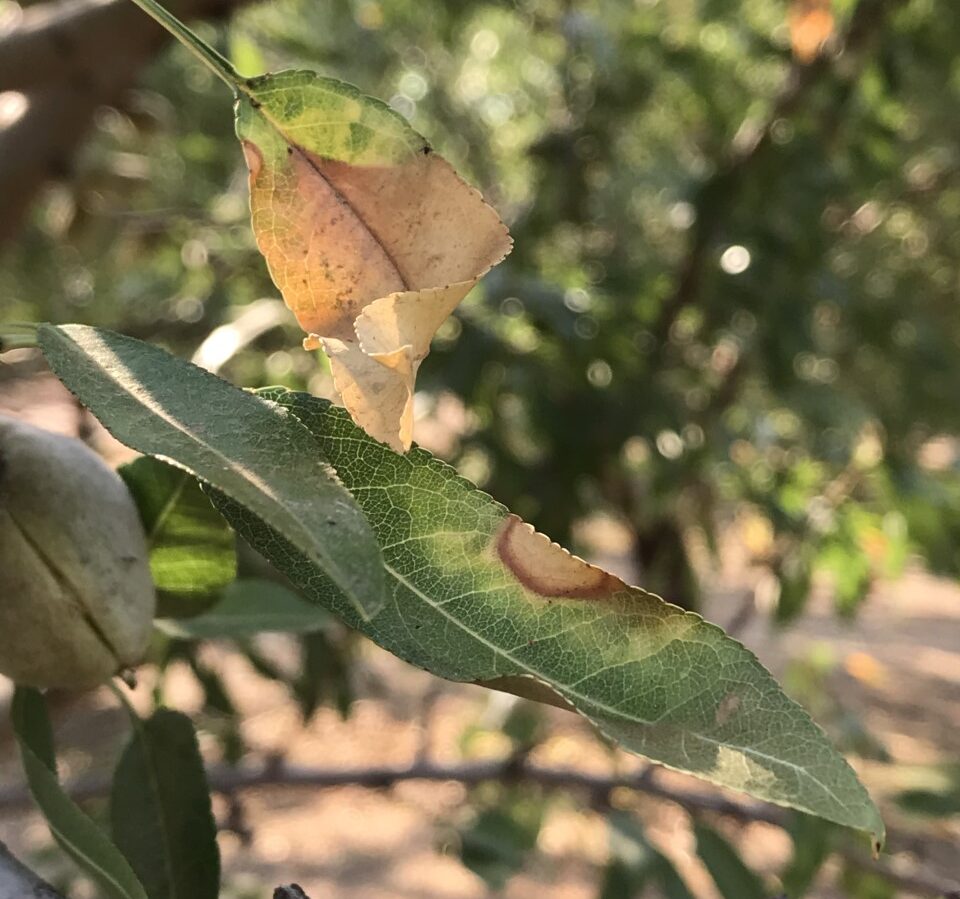
An almond disease that has been present in California since at least the 1950s raised concerns last year among growers and UCCE advisors when symptoms began showing up in Sacramento Valley orchards.
Although this disease has been present for at least 70 years, UCCE advisors noted that it only surfaces periodically. They also reported that warmer summer and winter temperatures appear to increase disease prevalence. There is a concern that ALS could move from a minor issue for the industry to a potentially serious problem as the climate changes.
ALS has predominantly been found in the Sacramento Valley. As reported in UCCE’s Sacramento Valley Almond News, the disease was confirmed in 2020 at the California State University Chico Farm at the Regional Almond Variety Trial.
UCCE Orchard Systems Advisor Luke Milliron said it appears that almond leaf scorch (ALS) is ubiquitous in the Chico State orchards. A survey to confirm presence of the disease was inconclusive, he added, as the pathogen is difficult to isolate.
Incidence of the disease this year has reportedly been low, said Drew Wolter, Almond Board of California’s senior pest management specialist. A spike in the disease would have happened during the hottest months.
ALS is a disease caused by the bacterium Xylella fastidiosa, the same bacteria that causes Pierce’s Disease in grapes.
UCCE’s Sacramento Valley Almond News reports that the bacteria live in the xylem of the tree and reduce the flow of water to leaves. Leaf tissue dies due to insufficient water. ALS symptoms show on individual leaves in early June to mid-July. The leaf tips first turn light green to yellow with the leaf scorching at the onset of hot weather.
Growers who suspect a tree is infected with ALS should use July leaf samples to detect salt levels as salt burn symptoms can mimic ALS. It stands to reason, Milliron said, because drought-stressed trees, or those irrigated with low-quality water, can have leaves that exhibit symptoms similar to ALS. Unlike salt burn, leaves of ALS-infected trees may have a yellow margin between the normal green interior and the scorched or dried leaf edge.
Milliron said once a tree is infected, the disease may slowly progress. Symptoms of ALS can appear on a single branch or scaffold, but can spread to affect the entire canopy. Standard thinking has been that infected trees become progressively weaker and lose production and may die.
However, a group of USDA and UC researchers have contrary observations, showing that infected trees do not always dramatically decline, but can have a relatively stable infection that produces a relatively consistent yield decline each year.
It is important to identify and mark affected trees while the scorched areas of the tree canopy contrast clearly with healthy green leaves. After harvest and defoliation, signs of ALS are more difficult to detect.

ALS Vectors
ALS is vectored by sharpshooter leafhoppers or spittlebugs as they feed on the xylem. These insects carry the pathogen from plant to plant. The grass sharpshooter or green sharpshooter (Draeculacephala minerva) is the most common vector of this disease in Sacramento Valley almond orchards, according to a 2011 survey by UCCE Specialist Kent Daane and others.
Blue-green sharpshooter (Graphocephala atropunctata) and glassy-winged sharpshooter (Homalodisca coagulata) can also be vectors. The small, green potato leafhopper (Empoasca sp.), prune leafhopper (Edwardsiana prunicola) and the white apple leaf hopper (Typhlocyba pomaria) that commonly feed on almond leaves are not vectors of this disease.
Milliron said weedy fields adjacent to almond orchards could be a source of the infection. There is little evidence of tree-to-tree disease spread, but infected trees, infected weedy grasses and efficient vectors keep the pathogen moving. Irrigated pastures, weedy grasses, alfalfa and permanent cover crops are the most common habitat for sharpshooters in almond growing regions of California.
Wolter said the disease needs resident vegetation to act as a host plant for the disease. Properly managing resident vegetation can minimize the inoculum present in an orchard. This doesn’t mean bare ground is necessary, he noted, but it helps to keep middles mowed and tree rows clean if there is a history of the disease.
It can be hard to distinguish between salt burn and ALS, which leads to growers incorrectly diagnosing these foliar symptoms. It is best to send in leaf tissue samples for toxic salts to confirm a diagnosis.
Control and Prevention
No chemical or nutritional treatments control almond leaf scorch. In addition, no research or practical experience suggests that disease occurrence is reduced by controlling the vectors with insecticides.
USDA researchers previously showed that rootstock susceptibility to the disease varies. Nemaguard, research found, has resistance to infection, isolating ALS infections to the scion and eventually leading to disease remission. Nemaguard is widely planted in the San Joaquin Valley, but not widely planted or adapted for the Sacramento Valley. Since that work, the Sacramento Valley has become heavily reliant on Krysmk 86, which is untested as a Xylella fastidiosa host.
Finally, different types of Xylella fastidiosa have very different biology. There is some data showing one type (multiplex subspecies) in the Sacramento Valley and another type (fastidiosa subspecies) isolated in the San Joaquin Valley. Due to differences in strain, it is possible that varietal selection and breeding efforts as well as other disease management measures will have to be distinct in the Sacramento Valley.
Early identification and removal of trees in young orchards less than 10 years old may minimize the problem and reduce additional tree losses. In orchards 16 to 20 years old, living with some infected trees until the orchard is removed and replaced is an option. However, that decision must depend on what is around the ALS-infected block. The infected trees may be jeopardizing an adjacent newly planted orchard and removal could be the best option.
Pruning out early infections in a single infected scaffold can be successful. However, cuts must be made at least five feet below the lowest symptomatic leaves to have any chance to save the rest of the tree. The pruned trees should be marked so they can be inspected the following year to see if the disease has been halted or if it has progressed.










